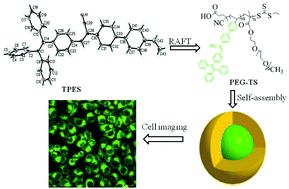A polymerizable aggregation-induced emission dye for fluorescent nanoparticles: synthesis, molecular structure and application in cell imaging†
Abstract
To adapt the application of fluorescent organic nanoparticles (FONs) based on aggregation-induced emission (AIE) in bio-systems, a novel polymerizable AIE dye named TPES was successfully synthesized by the Suzuki coupling reaction of TPEBr and 4-vinylphenylboronic acid, which belongs to the triclinic crystal system and P![[1 with combining macron]](https://www.rsc.org/images/entities/char_0031_0304.gif) space group as determined by a crystal structure analysis. Compared with the reported TBP dye, the fluorescence intensity of TPES with an obvious red shift of the emission wavelength was stronger. Subsequently, the obtained TPES monomer was incorporated into PEG-TS polymers by RAFT polymerization with about 47 000 molecular weight (Mn) and a narrow polydispersity index (PDI). When the feeding ratio of TPES increased to 25.0% from 16.0%, the molar fraction of TPES in PEG-TS polymers accordingly increased to 25.6% from 15.5%. In water solution, the as-prepared amphiphilic PEG-TS1 and PEG-TS2 polymers tended to self-assemble into FONs with about 150 nm and 400 nm diameters, and their fluorescence spectrum presented the maximal emission peak at 515 nm with an obvious AIE phenomenon. Furthermore, due to their high water dispersibility, good fluorescence and excellent biocompatibility, the as-prepared PEG-TS polymers are attractive for the application in cell imaging.
space group as determined by a crystal structure analysis. Compared with the reported TBP dye, the fluorescence intensity of TPES with an obvious red shift of the emission wavelength was stronger. Subsequently, the obtained TPES monomer was incorporated into PEG-TS polymers by RAFT polymerization with about 47 000 molecular weight (Mn) and a narrow polydispersity index (PDI). When the feeding ratio of TPES increased to 25.0% from 16.0%, the molar fraction of TPES in PEG-TS polymers accordingly increased to 25.6% from 15.5%. In water solution, the as-prepared amphiphilic PEG-TS1 and PEG-TS2 polymers tended to self-assemble into FONs with about 150 nm and 400 nm diameters, and their fluorescence spectrum presented the maximal emission peak at 515 nm with an obvious AIE phenomenon. Furthermore, due to their high water dispersibility, good fluorescence and excellent biocompatibility, the as-prepared PEG-TS polymers are attractive for the application in cell imaging.



 Please wait while we load your content...
Please wait while we load your content...